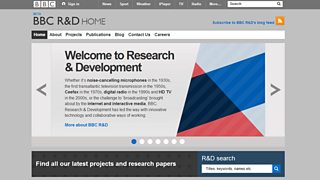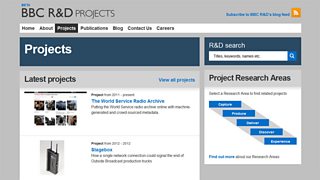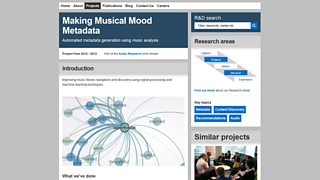Within the �������� Research & Development team called Internet Research and Future Services I work on all things Web, from coordinating our work defining future standards with the to making sure we use the full potential of the web in our research and prototypes.
That includes making sure we use the web efficiently to communicate our department's research and so, this week, we are releasing a beta version of the new .

The new R&D website
The��R&D department of the �������� is fairly unique. Even in the media and broadcast industry, few organisations conduct research along the whole broadcast chain.
�������� R&D has been driving innovation in the of audio and video, the tools and processes and the of content through cables and airwaves, from the early designs of radio microphones to digital and high definition television.
We also look at new and better ways to help our audiences and our programmes. The broadcast chain and those are a key aspect of our identity and you will find them at the very heart of our new website.
Another reason why our R&D department is quite unique is that we don't just create insight and innovation for the ��������, but for the whole industry. Openness and collaboration is in our DNA and that means we have to work very hard to make sure that potential partners for our research know exactly what we are up to and that anyone in the industry can easily find the body of work we have been building since the 1930s.
So when we set out to refresh our website at the end of the summer of 2012 we aimed to:
- Showcase the exciting work happening at �������� R&D,
- Make it really easy to find relevant content from the research and knowledge accumulated over the decades,
- And in the long run, build an online space where �������� R&D can truly act as a catalyst for world-class research and development for our industry.
Easier said than done, but we knew we had a few good tools at hand to give it a fair try: several of our recent projects revolved around the idea of or using the web to explore . In other words this was a case of eating our own dog food.

Search for content around the five research areas
What did our experience tell us? Mainly that we should not design and constrain every possible way people could discover our content. That thinking in terms of ‘user journeys’ or linear narratives through our archives would hinder, not help, the discovery.
Instead we aimed to make discovery as free-flowing as possible by:
- Defining what the ‘things’ we wanted to present are: people, projects, publications and so on.
- Giving each thing a page and a page per thing.
- Linking things together and presenting relations in context.
In effect it means that a visitor to the site should be able to land on any page (from a link or a search engine query) and navigate from there, hopping from a journal publication to the project which it documents, to the profile of an engineer who worked on the project, to an index of the research topics that person specialises in, and so on, without end.
If we could replicate the enthralling experience of , if our visitors occasionally got lost in the wealth of content rather than getting lost in the complex mesh of expert jargon and acronyms, we would know we had succeeded.
Unfortunately such a heavily interlinked architecture of information made it nearly impossible to re-build our site with typical (CMS), where pages tend to be organised in a single tree of parent and child pages and with a single set of categories.��
Working with the usual in-house systems used at the �������� was, for the same reasons, out of the question. After much testing we eventually settled on the little known but powerful , an CMS with a knack for connecting things together and a nice back-end interface to manage both the content and its complex network of relationships.

Content tagged around research topics
��
We also needed a simple vocabulary to describe what �������� R&D does. That too was an interesting challenge given our long history and diverse body of work. When we compiled all the tags and keywords used in the past to describe our work the total ran over 2000 words!
It took us quite a few card sorting exercises, a sprinkle of diplomacy (we R&D engineers can get attached to our pet keywords), a few arbitrary decisions (Delivery or Distribution? Both very suitable. Flip a coin.) and a lot of patience to end up with two ways of categorising our projects:
- The five stages of the broadcast chain - as mentioned earlier,
- And a small vocabulary of less than .
By ‘tagging’ every project and other content on the site with those research topics we are able to build automated indexes to facilitate discovery.
One reason to limit the number of topics for navigation is that we wanted each of them to aggregate a decent amount of content. What's the point of ‘tag clouds’ where each topic is, at best, shared by only a couple of items? Our topics are a little broad but it means that anyone can easily browse through the breadth of work we've done in areas such as audio or .
The other reason to keep the list to a reasonable length is that we wanted to keep it all at a human scale. A scary long list would play against that. That ‘human’ factor was also a reason why we put a certain emphasis on people as a link between projects and why we toned down the visual design from an obsession with green fibre optics and other sorts of cables to something still unashamedly techie… but a little less so.
Throughout the project a lot of effort was put into making the site more user-friendly, but not just for its visitors.

The old R&D site
Early on we realised that our biggest challenge would be to make it the site which R&D teams would naturally use on a daily basis to learn about what the rest of the 200-strong department is up to, collaborate with our many project partners and communicate with the world in a spirit of open innovation.
This remains our challenge, even though we have already made it so that our colleagues can publish information and updates about their projects in an easier way than ever before.
We are planning for more content to be added or migrated from the 'old' site and features to be added beyond the current beta period. One such feature is the , which we are integrating with the main R&D site.
There won't be any way to comment on blog posts for the time being as we take the time to figure out how to best create and nurture conversations around the new site. In the meantime we welcome conversations on twitter. You can find us there at .
As you will see it is still a beta. So please tell us your thoughts, hunt for and report bugs you encounter and with your help we will continue building an ever-evolving, truly world-class website for research and innovation in broadcast and media.
Olivier Thereaux is a senior technologist in �������� R&D.��
